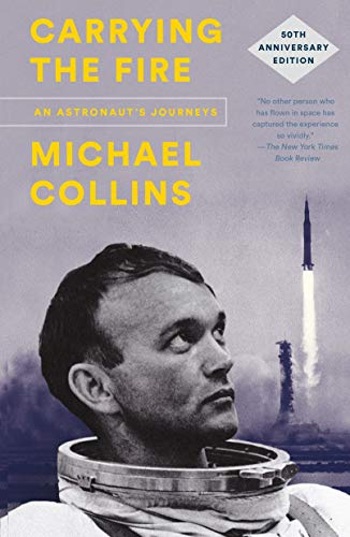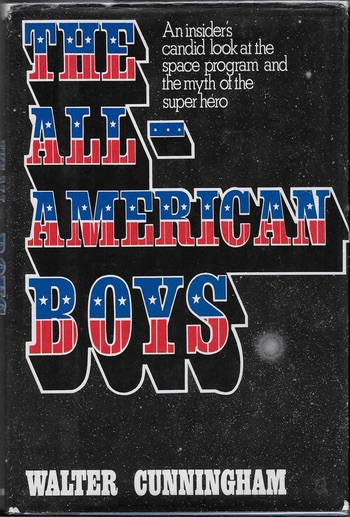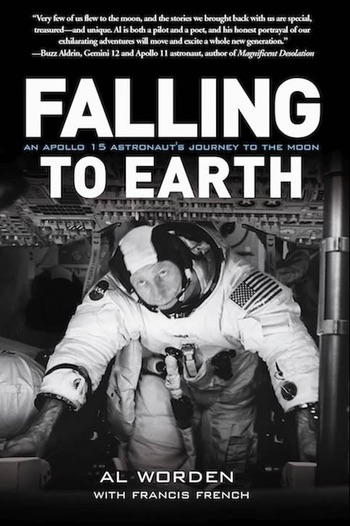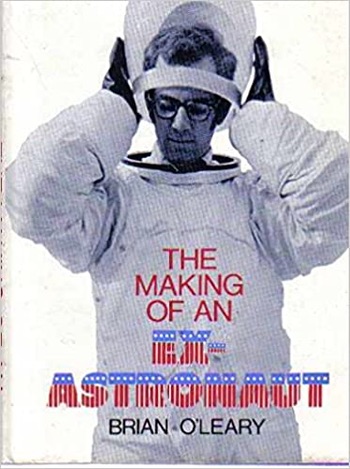The genre-defining astronaut/ex-astronaut autobiographiesby Emily Carney
|
| You can envision a bespectacled O’Leary, age 27, walking around Houston’s Manned Spacecraft Center, looking bewildered, out-of-place, and anxious as he realizes he got himself waaaaaaaay in over his head with a job he can’t quite fulfill. |
This essay will spotlight four books that defined one sub-genre in spaceflight literature: the astronaut (or, in one case, ex-astronaut) autobiography. These autobiographies are listed in chronological order, by publication date. While it would be impossible due to space and time constraints to list every astronaut memoir, these four titles are often cited as having inspired other astronauts and spaceflight personalities in his or her own storytelling endeavors.
The Making of an Ex-Astronaut, by Brian O’Leary (Houghton Mifflin Company, 1970)
Published 50 years ago, this choice might be somewhat controversial. Dr. Brian O’Leary, perhaps NASA’s most famous (or infamous?) ex-astronaut, doomed himself to a permanent exile from the fighter jock-heavy astronaut corps with the sentence, “Flying just isn’t my cup of tea.” But O’Leary’s 1970 sort-of-memoir mixed with op-ed essays, The Making of an Ex-Astronaut, was the first autobiographical work that began to lift the veil obscuring the astronaut corps during 1960s NASA. (Another work that would fully lift the veil will be discussed later.) Moreover, it set the scene. You can envision a bespectacled O’Leary, age 27, walking around Houston’s Manned Spacecraft Center, looking bewildered, out-of-place, and anxious as he realizes he got himself waaaaaaaay in over his head with a job he can’t quite fulfill. Many of us have been exactly where O’Leary was at the time—except unlike us, his resignation would be broadcast all over the world.
O’Leary introduced several tropes that would become par for the course in astronaut autobiographies and spaceflight books, including ones on this list. For example, he “rated” his fellow 1967 “Excess Eleven” astronaut group colleagues, very much how Michael Collins rated his colleagues in Carrying The Fire. He detailed the selection process and candidates, which included a then-unknown, pre-High Frontier Princeton professor named Dr. Gerard K. O’Neill (who didn’t quite make the cut for this group.) This “selection process” trope would be repeated to great effect in Tom Wolfe’s 1979 book, The Right Stuff. However, O’Leary—who had the benefit of youth and foresight when this book was written and published—turns the genre on its head, and soon we’re seeing how the realities and pressures of the job could be discouraging.
While he lingered a bit too long on how much he dislikes hot, sticky Houston (one whole chapter!), he made cogent points about how the astronaut cadre, focused on the singular task of landing on the Moon, made little effort in exploring the science of the Moon. Indeed, the Apollo lunar program only boasted three science-intensive missions, and those were tacked on at the program’s end. Near the end of his brief stint as one of America’s Newest Heroes, he’s receiving phone calls from horny “Cape Cookies” he’s never even met, and he’s crying in his car as he crosses a bridge to the ethereal strains of Simon and Garfunkel’s “Scarborough Fair,” terrified of going back to the NASA-mandated U.S. Air Force flight school. O’Leary goes resolutely against the grain of the archetypal mid-1960s Ken doll astronaut, and I am here for it. With this distinctly un-macho admission (that could be seen as embarrassing, particularly in 1970 as the United States was still savoring its Apollo 11 victory), O’Leary established another astronaut autobiography trope: the “come to Jesus” moment, when there’s no turning back from the truth.
| Never before has a reader been so close to the Moon, and never before did an astronaut allow himself to be vulnerable enough to let us into his insular world, sans test pilot bluster. |
As the book comes to its close, O’Leary begins to turn his vision to the futurism that would later spark a long collaboration with aforementioned O’Neill, the father of space settlements: “We should never lose sight of our ultimate goal in space: to understand nature and ourselves better by exploring the universe. The most exciting discovery to mankind may result from this exploration – the first contact with another intelligent civilization living among the heavenly bodies… Even without a reply, we are summoned to travel through light years of cold interstellar space and discover the secrets of the planets circling the nearby stars.” These words predicted the visionary language that O’Neill and another working space scientist, Dr. Carl Sagan, would use within that decade.
While The Making of an Ex-Astronaut was criticized by many of O’Leary’s former colleagues and was not a massive success upon its release (perhaps aided by the public’s increasing lack of interest in spaceflight), this book did establish a template for future astronaut reminiscences, and for 1970s writing about futurism. While it is long out of print, you should track down a used copy, and read it to experience O’Leary’s—and NASA’s—1967 world.
O’Leary’s age at publication: 30
Years resigned from NASA: Two-and-a-half
 |
Carrying the Fire: An Astronaut’s Journeys, by Michael Collins (Farrar, Straus and Giroux, 1974)
O’Leary’s reminiscences may have introduced several now well-known tropes to the genre, but Michael Collins—of Gemini 10 and Apollo 11 fame—firmly established the template for astronaut autobiographies with 1974’s Carrying the Fire. Published five years after the first lunar landing and nearly two years after the Apollo Moon missions had ended, Collins’ descriptions of his selection, training, his colleagues, and his two space missions are fully engrossing and beautifully written.
Space historian Roger Launius wrote in a 2012 blog post, “It is a remarkably honest and reflective autobiography, and it extends a tradition of the aviator as litterateur into the age of space travel. Although written in 1974, and still available in inexpensive paperback editions, Carrying the Fire still has a freshness and crispness to it after some forty years.” Never before had an astronaut enjoyed a literary debut like this. Collins proved himself to be hilarious, spellbinding, and heartbreaking, sometimes within the limited space of a single page.
Few books can match Collins’ memories, five years removed, of the magnificent visions he saw during his jaunt as Apollo 11’s command module pilot. He wrote upon approaching the Moon, “The moon I have known all my life, that two-dimensional, small yellow disk in the sky, has gone away somewhere, to be replaced by the most awesome sphere I have ever seen. To begin with it is huge, completely filling our window. Second, it is three-dimensional. The belly of it bulges out towards us in such pronounced fashion that I almost feel I can reach out and touch it… The vague reddish-yellow of the sun’s corona, the blanched white of earthshine, and the pure black of the starstudded surrounding sky all combine to cast a bluish glow over the moon. This cool, magnificent sphere hangs there ominously, a formidable presence without sound or motion, issuing us no invitation to invade its domain. Neil [Armstrong, Apollo 11’s commander] sums it up: ‘It's a view worth the price of the trip.’ And somewhat scary too although no one says that.” Never before has a reader been so close to the Moon, and never before did an astronaut allow himself to be vulnerable enough to let us into his insular world, sans test pilot bluster.
However, Collins’ entry into the lunar lottery is nearly waylaid by a back injury with necessitates surgery. While this “come to Jesus” moment happens well before he’s inserted into Columbia atop a Saturn V in July 1969, at this point Collins establishes himself as a real writer with full command of language, and how it affects a reader. Check out his descriptions of the anesthetic haze he experiences, pre- and post-surgery: “Slice away, baby, I really didn’t care, and as they wheeled me into the operating room, I was only vaguely aware of very bright lights and some fool who wanted me to count backward from one hundred. I didn’t get very far… The next thing I remember is telling my wife a lot of very interesting things, but somehow her beautiful, sensitive face remained unaltered, impassive, as though she had not heard me. Finally, she drifted away, silently, and returned a long time later with Dr. Myers.” Collins straps the reader upon the operating table, helpless and prone, just as he pushes the same reader’s face ever so gently into face of the Moon. While history lets us know Collins made it through the surgery just fine, his writing puts us on the edge of our seats: will he recover? Will he ever be “normal” enough to walk again, much less go to space again?
| The Apollo 7 astronaut declared that the “super-hero astronaut” image, in fact, was a well-crafted, curated lie of sorts: “Some even cultivated the image, but few could measure up to it. Most of us recognized it was unlivable only slightly before we realized we were stuck with it for the rest of our lives.” |
While very few human beings ventured to the Moon between 1969 and 1972, Collins made a journey to our closest natural satellite accessible to everyone with Carrying the Fire. Written in what he called “my chicken scratchings” on yellow legal pads in longhand, then transferred to type, this book remains the gold standard in astronaut memoirs. Carrying the Fire was reissued last year in celebration of Apollo 11’s 50th anniversary, is available through most major book retailers, and is essential reading.
Collins’ age at publication: 43
Years resigned from NASA: Four
 |
The All-American Boys, by Walt Cunningham (Macmillan Publishing Co., Inc., 1977)
The preface to Walt Cunningham’s 1977 opus, The All-American Boys, opens with this paragraph: “Writing a book is an unusual experience. It makes people nervous, especially those being written about. Shortly after publication of the first astronaut-authored book I received a call from the Astronaut Office. I could almost hear the caller’s pulse throbbing at the other end of the line. ‘We have a copy in the office, but the boys are half afraid to open it. I hear it tells everything. I sure hope your book isn’t going to get into a lot of that gamey stuff.’” Well, Cunningham’s book did get into a lot of that gamey stuff—and we loved it. In the same preface, the Apollo 7 astronaut declared that the “super-hero astronaut” image, in fact, was a well-crafted, curated lie of sorts: “Some even cultivated the image, but few could measure up to it. Most of us recognized it was unlivable only slightly before we realized we were stuck with it for the rest of our lives.”
In 1970, former Major League Baseball pitcher Jim Bouton released a book called Ball Four, which was a diary of his 1969 season interspersed with memories of his time with the New York Yankees. This book tore apart the baseball community upon its release, as it revealed secrets of the clubhouse that had been long suppressed. For example, it depicted baseball hero Mickey Mantle as being a womanizing drunk, and uncovered how drug use—particularly amphetamine use—was rampant within the players’ ranks. Some were scandalized by Ball Four, but many saw Bouton’s testimony as what the public needed to hear: that when you peeled back an image, sometimes you got more image—or something even more unsavory.
Why am I discussing a baseball memoir? It’s because The All-American Boys functioned as the Ball Four of the space community. Here, Cunningham begins his memoirs with a searing depiction of the Apollo 1 fire. Once the reader has emotionally recovered (somewhat) from that, Cunningham recounts his astronaut career from 1963 selection to its rather ignominious end in Apollo Applications/Skylab, after he was forever associated with what was called the “Apollo 7 bitch circus” (even though he was largely a compliant crew member during that mission, unlike his two colleagues, Wally Schirra and Donn Eisele.) Indeed, the Apple TV series For All Mankind drew some inspiration from The All-American Boys when its NASA briefly relegated its archetypal astronaut hero, Ed Baldwin, to a dead-end desk job at Apollo Applications after a press interview gone terribly wrong.
The best parts of the book are when Cunningham spills the tea all over the reader entirely, and completely whips the “American hero” veil off some of his colleagues, and in turn, off NASA’s human spaceflight program. We find out that many of his colleagues weren’t faithful spouses, and that some were difficult and domineering—a far cry from their “salt of the Earth” public image. We find out a lot about famously single-and-swinging Jack Swigert’s dating habits (page 194: “Jack had kept her [a female reporter] on the back burner for ten months, and Sunday night was the night. We could hardly wait till Monday to see if he was still alive.”). Cunningham depicts a NASA complete with pockmarks and blemishes, and doesn’t even attempt to lift the airbrush to cover its surface.
When one completes The All-American Boys, you realize the title is more than a sarcastic scoff at what NASA wanted its heroes to be: you understand that Cunningham really was depicting “All-American boys.” For better and for worse, NASA’s astronauts, despite their slick, heavily curated public veneers, weren’t immune to the social problems faced by regular Americans during the 1960s. A revised and updated version of The All-American Boys was released in 2009, and has proved to be a popular addition to any spaceflight library, as Cunningham’s tea will never fail to be tasty.
Cunningham’s age at publication: 45
Years resigned from NASA: Six
 |
Falling to Earth, by Al Worden with Francis French (Smithsonian Books, 2011)
While I won’t ruin this book with spoilers for those who haven’t yet enjoyed it, Falling to Earth’s climactic point of crisis actually occurs after Al Worden, Apollo 15’s command module pilot, makes his historic trip to and around the Moon. It hinges around one day that upended his life in 1972, and he alludes to this upcoming human-versus-awful-situation conflict in the book’s preface: “That day… was the beginning of a long journey for me. As I clawed my way back to self-respect and the understanding of my peers, a sense of duty kept me from telling my painful story of disgrace and redemption. Recently, however, my feelings have changed. If I don’t tell this story myself, completely and with raw honesty, then all anyone will know about me will be an incomplete story told only by others. What really happened to me and why? It’s time for me to explain.” And explain he did, in what might be the most vulnerable, yet uplifting astronaut autobiography committed to paper.
| His manner of storytelling—candid and colorful—makes you feel like you’re listening to a good pal, who just happened to be an Apollo astronaut, tell you about his life and travails. |
While Brian O’Leary’s memoirs were written with the benefit of youth and foresight, Worden’s memoirs benefit from his maturity and insight into his actions nearly fifty years after the fact. We hear about his first marriage, which he freely (and regretfully) admits ended because of his inexperience at relationships and his single-minded dedication to work. He recounts, wistfully, that he wishes his Apollo 15 crew had enjoyed the closeness of Apollo 12’s friendships. You’ll laugh at some of his raunchier stories about his younger days as a test pilot, and you’ll be suitably awed by his descriptions of a Saturn V launch and a trip to the Moon. However, the book’s real jaw dropper, as mentioned before, happens just after Worden’s wildly successful role in Apollo 15, and many spaceflight fans, including this author, were never quite the same after reading it.
It is here Worden recounts what happened during the Apollo 15 stamp affair, and we discover where the fault of the incident actually lies. These admissions by Worden are especially painful; his career publicly scuttled, he is forced to flee Houston to NASA Ames in California, where he is subjected to further indignities (the center invites Karl Henize, a then-unflown astronaut, to a “Meet An Astronaut” day—except Worden, a flown Apollo astronaut, is forced to languish out of sight.) A romantic relationship in Houston comes to an end, and he’s iced out by too many of his former colleagues. He resigns his NASA post in 1975, but he’s still haunted by the scandal, and his sense of duty and propriety prevents him from discussing what he really endured for nearly 40 years.
What makes this section of Falling to Earth excruciatingly painful is that by this point in the book’s narrative, Worden isn’t just some random guy—he’s your friend. His manner of storytelling—candid and colorful—makes you feel like you’re listening to a good pal, who just happened to be an Apollo astronaut, tell you about his life and travails. So, when Worden is unceremoniously bounced from the specter (or illusion?) of perfect heroism, you feel like it’s happening to your nice, funny, cool friend, and it hurts terribly. Never has an astronaut memoir shown its hero in such a dark, sad, vulnerable place, and the effect upon the reader is incredibly moving.
Worden’s story, thankfully, has a wonderful ending. He again falls into NASA’s good graces, and regains the respect he desperately deserved years before. Following the 2011 publication of Falling to Earth, Worden, who died in March at age 88, enjoyed perhaps the best third act ever by an astronaut. He regularly spoke at events all over the world, received awards and honors (including recognition from Guinness World Records as having performed the deepest trans-Earth EVA, and including honors from the National Space Society), and, of course, signed a great many copies of his bestselling autobiography.
The man might be physically gone, but if you want to visit him, and hear him talk, vent, and laugh, you can always open any page of Falling to Earth, and it’s like he’s never gone anywhere.
Worden’s age at publication: 79
Years resigned from NASA: 36
This article is adapted from a series of blog posts previously published on the National Space Society’s website: see part one and part two.
Note: we are temporarily moderating all comments submitted to deal with a surge in spam.
